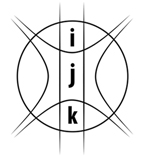2011 (7)
It is very revealing as Poincaré distinguishes between mathematical and physical continuity1, but it is even more interesting how he views the continuum. He introduces the concept of different orders of continuity; first-order continuity is what is provided by adding rational numbers to the number line, and second-order continuity is, which appears when irrational munbers also appear on the number line.2 __________________________________________________________ 1 As he described in his writing titled "Science and hypothesis", which is more an essay of philosophy of science, rather than a mathematical writing. 2 Quoting Poincaré: "For brevity let me call the set of members which form under the same laws as the sequence of rational numbers as the first-order mathematical continuity. If we insert now…
Sunday, 31 July 2016 21:52
Problems with the use of Cantor’s diagonal argument
Written by Mlakár Katalin
I begin with a quote, because I could not formulate better my starter thoughts of this writing. The quote is from the early 60s, but today it is still up-to-date. "... The whole of modern mathematics is essentially based on the concept (or idea) of the intense actual infinity. In set theory there is much less developed extensive idea of infinity. Cantor's predecessor, Bolzano, whose views have greatly influenced the formation of set theory, trying to find a solution to the infinite quantity (extensive infinity) problem. However, the set theory was formed as a very rich theory of intensive infinity, while the extensive concept of infinity was essentially a stranger."1 Cantor's concept of infinity is about extensive infinity, but he…
In the item titled "Two-element numbers and geometry” I mentioned that two-element numbers are closely related to infinity. Now, I should add that they also play an important role in different formulations of the (independent) continuum hypothesis, so in the descriptions of different mathematics. Cantor defined infinite numbers that are located beyond natural numbers. These are the transfinite numbers. I have got my idea for a new interpretation of infinite numbers from computer plotting of negative numbers. This method is similar to the usual decimal representation of fractions in the system of real numbers. For example, a special infinite number can be written as the following: ...999 So in the case of the ...999 number there is an infinite sequence…
I discovered two-element numbers for myself in the second half of 70’s. At that time it was difficult to obtain information about them, because there was no internet. I talked about it at the university ELTE, and I received material on Clifford and Cayley numbers. The two-element numbers, however, were simple, but they were as great and useful as complex numbers. By the way, one of them was just the complex number system. The other one I called hyperbolic numbers, since multiplying the numbers in this system we got the Lorentz transformation, ie, the hyperbolic rotation. The third most simple numbers were the parabolic numbers as I called them, in their system the picture of a product was an offset…
By two-element numbers I mean numbers which can be written in a + bw form where 'a' and 'b' are real numbers and w is a special number with following properties: w2 =- 1 or 0 or +1 and when w2 = 1, w is not the real ± 1 number. In the literature these are called as complex numbers, kinds of Study numbers or dual numbers and hyperbolic numbers or perplex numbers. In the item titled "Comparison of two-element numbers" I have already written about these numbers, their sum is represented as 'vector sum'. I also wrote about here that triangle inequality of these numbers is the same as in the spherical plane or the Euclidean plane or the…
Content: Two-element numbers have three basic systems, comparison of the properties of the complex, hyperbolic and parabolic (also known as Study's) number systems, basic arithmetic and geometric operations, a comparison of these, introduction of general exponential form, interpretation of trigonometric functions and hyperbolic functions on these number systems. (Literature: Catoni, other sources in http://arxiv.org )
"A common experience, when some colleague would try to explain some piece of mathematics to me, would be that I should listen attentively, but almost totally uncomprehending of the logical connections between one set of words and the next. However, some guessed image would form in my mind as to the ideas that he was trying to convey-formed entirely on my own terms and seemingly with very little connection with the mental images that had been the basis of my colleague's own understanding-and I would reply. Rather to my astonishment, my own remarks would usually be accepted as appropriate, and the conversation would proceed to and fro in this way. It would be clear, at the end of it, that…



